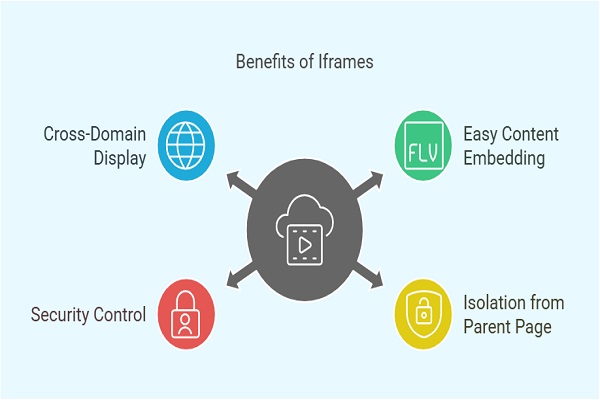HTML to Iframe Converter
What is an Iframe?
An iframe (Inline Frame) is an HTML element that embeds another webpage within the current page. It allows developers to display content from different sources without redirecting users. The <iframe> tag is used to create an iframe in HTML.
Basic Iframe Syntax:
<iframe src=”https://example.com” width=”600″ height=”400″ frameborder=”0″></iframe>
The src attribute specifies the URL of the external content. The width and height attributes define the dimensions of the iframe.
Benefits of Using Iframes

1. Easy Content Embedding
Iframes allow web developers to integrate external content, such as YouTube videos, Google Maps, and third-party applications, without complex coding.
2. Isolation from Parent Page
The content inside an iframe is independent of the parent page. This prevents conflicts between stylesheets and JavaScript code.
3. Security Control
Iframes can be configured with restrictions using the sandbox attribute to limit actions like script execution, form submission, and plugin usage.
4. Cross-Domain Content Display
Iframes allow webmasters to display content from external domains without hosting the files on their server.
How an HTML to Iframe Converter Works
An HTML to iframe converter simplifies the embedding process by generating the necessary iframe code automatically. Users enter the URL or HTML content, and the converter outputs an iframe code snippet that can be copied and pasted into a webpage.
Steps to Use an HTML to Iframe Converter:
- Input the URL: Enter the webpage URL you want to embed.
- Customize Settings: Adjust width, height, border, scrolling, and sandbox attributes.
- Generate Code: Click the convert button to get the iframe HTML code.
- Copy and Paste: Insert the generated code into your HTML document.
Popular HTML to Iframe Converter Tools
1. iFrame Generator
This tool allows users to generate iframe code with custom options like width, height, and scrolling settings.
2. Web Code Tools Iframe Generator
This online tool provides customizable iframe code with live preview options.
3. HTML Iframe Generator
A free tool that helps create iframe elements with custom styling and attributes.
Manually Creating an Iframe
Although converters automate iframe generation, knowing how to write iframe code manually is beneficial for customization and troubleshooting.
Steps to Create an Iframe Manually:
- Use the <iframe> tag:
<iframe src="https://www.example.com" width="600" height="400" frameborder="0"></iframe>
- Customize the appearance:
<iframe src="https://www.example.com" width="100%" height="500" style="border: 2px solid #ccc;"></iframe>
- Enable or disable scrolling:
<iframe src="https://www.example.com" width="600" height="400" scrolling="no"></iframe>
- Restrict functionality using the sandbox attribute:
<iframe src="https://www.example.com" sandbox="allow-scripts"></iframe>
Best Practices for Using Iframes

1. Make Iframes Responsive
Use CSS to make iframes adaptable to different screen sizes.
iframe {
max-width: 100%;
height: auto;
}
2. Optimize for SEO
Search engines may not index iframe content properly. Provide alternative text or links to the embedded content.
3. Ensure Accessibility
Add a title attribute to describe the iframe content for screen readers.
<iframe src="https://www.example.com" title="Embedded Webpage"></iframe>
4. Secure Iframes
Use the sandbox attribute to limit iframe permissions and prevent security vulnerabilities.
Common Issues and Troubleshooting
1. Iframe Not Displaying
- Check if the source URL is correct.
- Ensure the external site allows embedding.
2. Scrolling Not Working
- Use scrolling=”yes” or scrolling=”no” as needed.
3. Content Not Loading on HTTPS
- Ensure both the parent site and iframe source use HTTPS.
Conclusion
An HTML to iframe converter simplifies embedding external content into websites. Whether using an online tool or writing iframe code manually, developers can efficiently integrate web pages, videos, and interactive elements while maintaining security and accessibility. By following best practices, iframes can enhance website functionality without compromising performance or user experience.